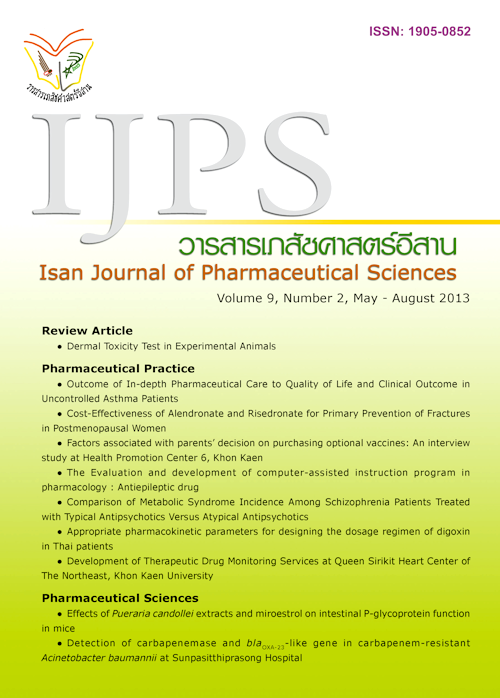the Evaluation and development of computer-assisted instruction program in pharmacology : Antiepileptic drug
Main Article Content
Abstract
Introduction : Epilepsy is chronic disease. It is necessary use epileptic drugs to control disease progression. Pharmacists being medicine experts should know about epileptic drugs. Increasingly, computer-assisted instruction program (CAI) is being used in pharmacy education. This study was a quasi-experimental design and compared traditional pharmacology learning with CAI using a lesson on seizure for fifth year pharmacy students. Thirty students were included into this study and divided into two groups by simple randomized method. The control group received handouts and studied by themselves. The intervention group used CAI and also studied by themselves. The outcomes were pretest and posttest scores, comments and satisfaction of both groups. Instruments and method: Both groups were evaluated for knowledge by pre and post-testing and opinions by questionnaire. In addition, CAI program quality was evaluated by the intervention group. Result : Post test scores of both groups were significantly higher than pre-test scores (p=0.001). On the other hand, there were no significant differences in post-test score between control and intervention group. The scores of opinion of the media, the knowledge, media interest, appropriate content, appropriate study period and satisfaction of the intervention group were significantly higher than the control group (p<0.05). However, the intervention group suggested that each content should provide questions, case studies, figures in an appropriate of time. In addition, sound and graphic as well as the sequence of contents should be consistency. In conclusion: CAI of antiepileptic drugs lesson enhanced self-study. Moreover, it helped to increase the satisfaction of self-study learning and reviewing. CAI could be an alternative method for pharmacy students to improve the effectiveness of their study by supplementing the traditional pharmacology lectures.
Article Details
In the case that some parts are used by others The author must Confirm that obtaining permission to use some of the original authors. And must attach evidence That the permission has been included
References
Basturk R. The effectiveness of computer-assisted instruction in teaching introductory statistics. Educational Technology & Society 2005; 8: 170-178.
Campagnolo DI, Stier KT, Sanchez W, et al. Spinal cord injury computer assisted instruction for medical students. Am JPhys Med Rehabil 2003; 82:316–319.
Chinvarun Y. Thailand Comprehensive Epilepsy Program [Serial Online]. 2009 Jul 20 [cited 2009 Jul 25]; [3 screens]. Available from http://www.thailandepilepsy.org/?p=108.
Chisholm MA, Joanne D, Poirier S. Development and evaluation of a computer-assisted instructional program in an advanced pharmacotherapeutics Course. Am J Pharm Educ 1996; 60: 365-369.
Hepler CD, Strand LM. Opportunities and respon sibilities in pharmaceutical care. Am J Hosp Pharm 1990; 47: 533-543.
Jenkins S, Goel R, Morrell DS. Computer-assisted instruction versus traditional lecture for medical student teaching of dermatology morphology: a randomized control trial. J Am Acad Dermatol 2008; 59(2): 255-259.
Kongsamai P. Evaluation of a computer assisted instructional (CAI) program for pharmacology laboratory. Master’s Thesis. Graduate School. Mahidol University. 2000.
Kunawaradisai N, Chanakit T, Saentaweesook N, et al. Evaluation of Computer Assisted Instruction in Basic Knowledge and Pharmacotherapy for Smoking Cessation. IJPS 2010; 6(2): 18-29
Mac TL, Tran DS, Quet F, Odermatt P, Preux PM, Tan CT. Epidemiology, aetiology, and clinical management of epilepsy in Asia: a systematic review. Lancet Neurol 2007; 6: 533–543.
Plasschaert AJ, Cailleteau JG, Verdonschot EH. The effect of a multimedia interactive tutorial on learning endodontic problem-solving. Eur J Dent Educ 1997; 1(2):66–69.
Rogers SJ, Cavazos JE. Epilepsy. In Dipiro JT, Talbert RL, Yee GC, et al, editors. Pharmacotherapy A Pathophysiologic Approach. 7th ed. Unitedstate: McGraw-Hill; 2008 : 927-951.
Rosenberg H, Grad HA, Matear DW. The Effectiveness of Computer-Aided, Self-Instructional Programs in Dental Education: A Systematic Review of the Literature. Journal of Dental Education. 2003; 67(5) : 524-532.
Siracuse MV, Sowell JG. Doctor of Pharmacy Students’ Use of Personal Digital Assistants. American Journal of Pharmaceutical Education 2008; 72 (1) : 1-7.
Thomerson JD. Computer assisted instruction vs. traditional instruction in an advance level computer course. Issues In Information Systems 2006; 7: p.114-118.
Wang L. Computer – Simulated Pharmacology Experiments For Undergraduate Pharmacy Students: Experience From An Australian University. Indian J Pharmacol 2001; 33: 280-282.
World Health Organization. Epilepsy [Online]. [cited 2009 Jul 25]; [3 screens]. Available from http://search.who.int/search?ie=utf8&site=default_collection&client=WHO&proxystylesheet=WHO&output=xml_no_dtd&oe=utf8&q=epilepsy&sitesearch=.


